This chapter explains common printing tasks.
This chapter includes:
![[Note]](../common/note.png)
|
|
|
The procedures in this chapter are mainly based on Windows XP. |
Your printer drivers support the following standard features:
-
Paper orientation, size, source, and media type selection
-
Number of copies
You can also use various special printing features. The following table shows a general overview of features supported by your printer drivers:
![[Note]](../common/note.png)
|
|
|
Some models or operating systems may not support all feature(s) shown in the following table. |
|
Feature |
PCL/PS[a]/XPS |
PS |
||
|---|---|---|---|---|
|
Windows |
MAC |
Linux |
Unix |
|
|
Machine quality option |
● |
● |
● |
● |
|
Poster printing |
● |
|||
|
Multiple pages per sheet |
● |
● |
● |
● |
|
Booklet printing |
● |
● |
● |
● |
|
Fit to page printing |
● |
● |
||
|
Reduce and enlarge printing |
● |
● |
||
|
Different source for first page |
● |
● |
||
|
Cover page options |
● |
● |
● |
● |
|
Raster compression |
● (PCL only) |
|||
|
Finishing options |
● |
● |
● |
● |
|
Output options |
● |
● |
● |
● |
|
Watermark |
● |
|||
|
Overlay |
● (PCL only) |
|||
|
Double-sided printing (duplex) |
● |
● |
● |
● |
|
[a] The PostScript driver is recommended for best print quality from PostScript-based applications such as Acrobat Reader®, Adobe Illustrator®, Adobe Photoshop®, etc. |
||||
(●: Supported, Blank: Not supported)
![[Note]](../common/note.png)
|
|
|
The following window is for Notepad in Windows 7. Your window may differ, depending on your operating system or the application you are using.
-
Open the document you want to print.
-
Select from the menu.
-
Select your machine from the list.
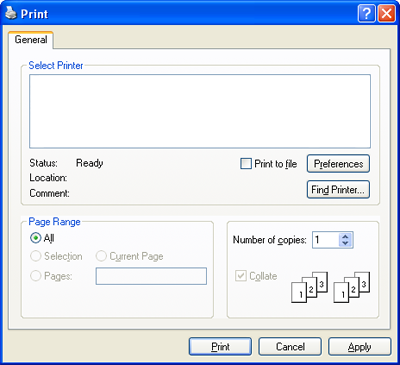
The basic print settings, including the number of copies and print range, are selected within the window.
![[Note]](../common/note.png)
To take advantage of the printer features provided by your printer driver, click or in the application’s window to change the print settings (see Opening printing preferences).
-
To start the print job, click or in the window.
Canceling a print job
If the print job is waiting in the print queue or print spooler, cancel the job as follows:
-
You can access this window by simply double-clicking the machine icon (
 ) in
the Windows task bar.
) in
the Windows task bar. -
You can also cancel the current job by pressing
 () on the control
panel.
() on the control
panel.
![[Note]](../common/note.png)
|
|
|
When you select an option in , you may see a warning mark, |
-
Open the document you want to print.
-
Select from the menu.
-
Select your printer driver from the list.
-
Click or .

![[Note]](../common/note.png)
You can check the machine’s current status pressing the button .
Favorites tab

tab

This option allows you to select the direction in which information is printed on a page.
This option allows you to select various ways to layout your document.
-
: This option is a basic layout option. This option allows you to print a page on one side of a sheet of paper.
-
: see Printing posters.
-
: This option allows you to print your documents with border lines. This option is not available for and .
This option allows you to print on both sides of a sheet of paper (see Printing on both sides of the paper).
This option allows you to specify the number of staples.
![[Note]](../common/note.png)
|
|
|
Use the tab options to set the basic paper handling specifications.
Click the tab to display the options shown below.

This option allows you to choose the number of copies to be printed. You can select 1 to 9999 copies.
-
: This option allows you to set the actual paper size of the originals.
-
: This option allows you to scale your print job to any selected paper size regardless of the original’s size (see Fitting your document to a selected paper size).
-
: This option allows you to change the size of a page’s contents to appear larger or smaller on the printed page by entering a percentage for reduction or enlargement (see Change the size of your document).
-
-
: Make sure that is set to the corresponding paper tray. Use when printing on special materials, such as envelopes and transparencies.
-
: This option allows you to set the type of paper to be loaded in the tray. This will let you get the best quality printout. If not, the desired print quality may not be achieved.
-
: This option is allows you to make special pages such as covers. You can add, delete, or update the special page settings to the list. This option is available only when you use the PCL printer driver.
tab
Use the tab options to adjust the print quality for your specific printing needs.

Document Type
You can the document’s type. This option allows you to set the actual type of the originals.
You can choose color options. Setting this option to typically produces the best possible print quality for color documents. If you want to print a color document in grayscale, select .
To adjust color manually, click . Simply slide the color balance slider in the tab to adjust color, or click the tab for driver provided color correction for general image processing.
Click the question mark (![]() ) in
the upper-right corner of the window and click on any option
for more information.
) in
the upper-right corner of the window and click on any option
for more information.
![[Note]](../common/note.png)
|
|
|
Select to print text darker than in a normal document.
Check to print in solid black, regardless of the color it appears on the screen.
Click the question mark (![]() ) in
the upper-right corner of the window and click on any option
for more information.
) in
the upper-right corner of the window and click on any option
for more information.
-
For the PCL printer driver:
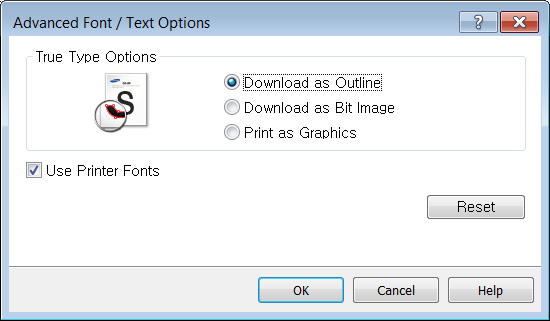
-
For the PS printer driver:
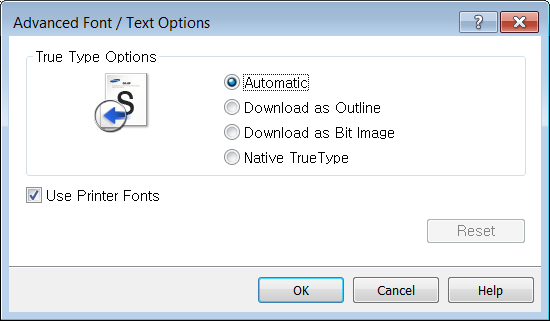
![[Note]](../common/note.png)
|
|
|
If you click , settings in the option return to the default setting. |
tab

-
: This option allows you to sort out the printouts easily.
-
: Disables this option.
-
: When printing multiple copies, this option shifts the output position of each set.
![[Note]](../common/note.png)
This feature is available only when the Inner Finisher is installed.
-
: When printing multiple copies, the printouts are stacked criss-crossed in sets.
![[Note]](../common/note.png)
-
This feature is available only when the standard or booklet finisher is not installed.
-
This feature is available only with Letter- and A4-sized print media.
-
Before using this feature, you have to load the paper in the trays with SEF (Short edge feed) and LEF (Long edge feed). For example, direction of paper feeding in the tray 1 is SEF, and direction of paper feeding in the tray 2 is LEF.

-
-
-
: This option allows you to specify the number of staples and the staple position. This option is available only when the optional Inner Finisher is installed.
-
: This option allows you to specify the tray where to output the printed documents (see Tray setting”).
tab
Use the tab to set various printing options.

see Using watermarks.
see Using overlay.
-
: This options allows you to set the sequence in which the pages will print. and are available only when you use the PCL printer driver.
-
: This option allows you to specify not to print blank pages in the original data.
-
: This option allows you to specify the binding margin. Binding margin adjusts the binding position. This option is not available when you use the PS printer driver.
-
: These options are available only when you use the PS printer driver. Click the question mark (
 ) in
the upper-right corner of the window and click on any option
you want to know about.
) in
the upper-right corner of the window and click on any option
you want to know about.
![[Note]](../common/note.png)
|
|
|
If you click , settings in the option return to the default setting. |
Encrypts printing data first, and transmits it to the machine. This feature protects the print information even though the data is snatched on a network. feature is enabled only when the hard drive is installed. The hard drive is used to decrypt the print data.
This option allows you to print with the given permission.
-
: If you check this option, only users with user permission can start a print job.
-
: If you check this option, only groups with group permission can start a print job.
![[Note]](../common/note.png)
|
|
|
tab
The tab allows
you to save print resources and lead you to eco-friendly printing. When
you select , you
can see the eco image ( )on
some options. Also, Some options are not available
in eco mode.
)on
some options. Also, Some options are not available
in eco mode.

-
: If you select this option, this feature is determined by the setting you’ve made on the control panel of the machine.
-
:
-
: Eco mode gets activated. Select , , , and you want to use in eco mode. As long as you do not change the options from the other tabs, the document will be print out as set in the eco mode.
-
: If the administrator sets in for this machine, the eco mode is always set by this machine’s eco setting, while the in the printer driver is disabled. If you need to change the print settings, click and enter the password or contact your administrator.
shows the result of reduced emission of carbon dioxide, used electricity, and the amount of saved paper in accordance with the settings you selected.
![[Note]](../common/note.png)
|
|
|
tab
Use the tab to display the copyright and the version number of the driver. If your computer is connected to the Internet, you can have access to additional device services.
This option allows you to choose how to print or save the print file by using the HDD in your machine. The default is which is for printing without storing the printing file on the HDD. You can also use this option in other tabs.
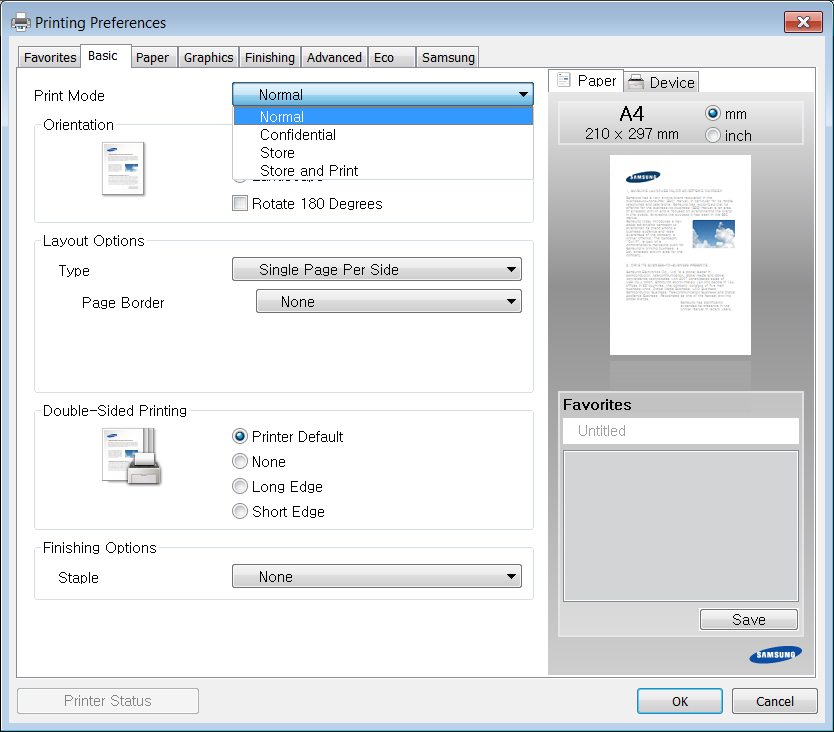
-
: This mode prints without storing your document.
-
: This mode is used for printing confidential documents. You need to enter a password to print using it .
-
: This mode is used only for storing documents on the HDD. If necessary, you can load and print the stored documents. You can find the stored file in the . First, choose a Stored Document in and then set .
-
: This mode is used when printing and storing documents at the same time. If necessary, you can load and print the stored documents. You can find the stored file in the . First, choose a Stored Document in and then set .
![[Note]](../common/note.png)
|
|
|
Using a favorite setting
The option, which is visible on each preferences tab except for tab, allows you to save the current preferences settings for future use.
To save a item:
-
Change the settings as needed on each tab.
-
Enter a name for the item in the input box.
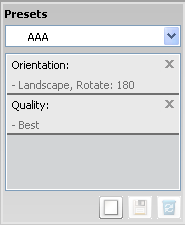
-
Click
 . Then
all current driver settings are saved. If you want to update
the setting you made, select more options and click
. Then
all current driver settings are saved. If you want to update
the setting you made, select more options and click  .
.To use a saved setting, select it from the drop-down list. The machine is now set to print according to the setting you selected.
To delete a saved setting, select it from the drop-down list and click
 .
. You can also restore the printer driver’s default settings by selecting from the drop-down list.
Click the question mark in the upper-right corner of the window and click on any option for more information. Then a pop-up window appears with information about that option's feature which is provided from the driver.
If the question mark does not appear, select the option you want to know about and press on your keyboard.
If you want to search information via a keyword, click the tab in the window, and enter a keyword in the input line of the option.
When you install the optional devices such as optional dual cassette feeder, Inner Finisher, etc, this machine automatically detects and sets the optional devices. If you cannot use the optional devices you installed in this driver, you can set the optional devices in . Job Accounting allows you to print with the given permission.
-
Click the Windows menu.
-
For Windows 2000, select > .
-
For Windows XP/2003, select .
-
For Windows 2008/Vista, select > > .
-
For Windows 7, select > > .
-
For Windows Server 2008 R2, select > > .
-
-
Right-click your machine.
-
For Windows XP/2003/2008/Vista, press .
-
For the PS driver, select the PS driver and right-click to open .
For Windows 7 and Windows Server 2008 R2, from context menus, select the .
![[Note]](../common/note.png)
If item has a ► mark, you can select other printer drivers connected with the selected printer.
-
-
Select .
![[Note]](../common/note.png)
The window may differ depending on the driver or operating system you are using.
-
Select the appropriate option.
-
: Select the optional tray you installed. You can select the (dual cassette feeder).
-
: Select the optional finisher you installed.
-
Administrator Settings: You can select the and .
-
: Select one of the options. This option is available only when you use the PS printer driver. Click the question mark (
 ) in the
upper-right corner of the window and click on any option
you want to know about.
) in the
upper-right corner of the window and click on any option
you want to know about.![[Note]](../common/note.png)
If you click , settings in the returns to the default setting.
-
: Displays the font substitution table and options for changing the TrueType-to-printer font mapping. This option is available only when you use the PS printer driver.
-
: Allows you to associate user and account identification information with each document you print.
-
: If you check this option, only users with user permission can start a print job.
-
: If you check this option, only groups with group permission can start a print job.
![[Note]](../common/note.png)
-
If you want to encrypt job accounting password, check .
-
Administrators can enable job accounting and configure permissions in the control panel or SyncThru™ Web Service. For the detailed information about them, refer to the Administrator’s Guide.
-
-
-
Click until you exit the or window.
Using special print features
Special print features include:
You can select the number of pages to print on a single sheet of paper. To print more than one page per sheet, the pages will be reduced in size and arranged in the order you specify. You can print up to 16 pages on one sheet.
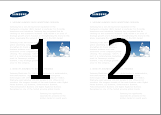
-
To change the print settings from your software application, access (see Opening printing preferences).
-
Click the tab, select in the drop-down list.
-
Select to print a border around each page on the sheet.
-
Select the number of pages you want to print per sheet (2, 4, 6, 9, or 16) in the drop-down list.
-
Select the page order from the drop-down list, if necessary.
-
Click the tab, select the , , and .
-
Click or until you exit the window.
This feature allows you to print a single-page document onto 4, 9, or 16 sheets of paper, for the purpose of pasting the sheets together to form one poster-size document.
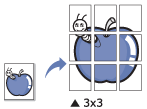
-
To change the print settings from your software application, access (see Opening printing preferences).
-
Click the tab, select in the drop-down list.
-
Select the page layout you want.
Specification of the page layout:
-
Select the value. Specify in millimeters or inches by selecting the radio button on the upper right of tab to make it easier to paste the sheets together.

-
Click the tab, select the , , and .
-
Click or until you exit the window.
-
You can complete the poster by pasting the sheets together.
You can print on both sides of a paper; duplex. Before printing, decide how you want your document oriented. You can only use this feature with Letter-, Legal-, Oficio-, US Folio-, A4-, ISO B5-, JIS B5-, Statement-, Executive-, A5-, 8K-, 16K-, Ledger- or JIS B4-sized paper.
![[Note]](../common/note.png)
|
|
|
Do not print on both sides of the special media, such as labels, envelopes, or thick paper. It may cause a paper jam or damage the machine. |
-
To change the print settings from your software application, access (see Opening printing preferences).
-
Click the tab.
-
From the section, select the binding option you want.
-
: If you select this option, this feature is determined by the setting you’ve made on the control panel of the machine. This option is available only when you use the PCL printer driver.
-
: Disables this feature.
-
: This option is the conventional layout used in bookbinding.

-
: This option is the conventional layout used in calendars.
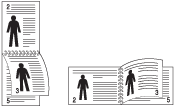
-
: Check this option to reverse the print order when duplex printing.
-
-
Click the tab, select the , , and .
-
Click or until you exit the window.
You can change the size of a document to appear larger or smaller on the printed page by typing in a percentage for reduction or enlargement.

-
To change the print settings from your software application, access (see Opening printing preferences).
-
Click the tab.
-
Select the actual paper size of the originals from the .
-
Enter the scaling rate in the input box.
You can also click the up/down arrows to select the scaling rate.
![[Note]](../common/note.png)
You cannot use this feature when you select a size of paper from the .
-
Select the and .
-
Click or until you exit the window.
This printer feature allows you to scale your print job to any selected paper size regardless of the document size. This option can be useful when you want to check fine details on a small document.
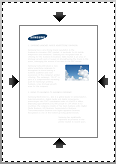
-
To change the print settings from your software application, access (see Opening printing preferences).
-
Click the tab.
-
Select actual paper size of the originals from the .
-
Select the size of paper to be printed in the tray from the .
-
Select the and .
-
Click or until you exit the window.
The watermark option allows you to print text over an existing document. For example, you use it when you want to have large gray letters reading “” or “” printed diagonally across the first page or all pages of a document.

There are several predefined watermarks that come with the machine. They can be modified, or you can add new ones to the list.
-
To change the print settings from your software application, access (see Opening printing preferences).
-
Click the tab, and select the desired watermark from the drop-down list. You will see the selected watermark in the preview image.
-
Click or until you exit the print window.
-
To change the print settings from your software application, access (see Opening printing preferences).
-
From the tab, select from the drop-down list.
-
Enter a text message in the box. You can enter up to 256 characters. The message displays in the preview window.
When the box is checked, the watermark prints on the first page only.
-
Select watermark options.
You can select the font name, style, color, size, and shade from the section, as well as set the angle of the watermark from the section.
-
Click to add a new watermark to the list.
-
When you finish editing, click or until you exit the window.
To stop printing the watermark, select from the drop-down list.
-
To change the print settings from your software application, access (see Opening printing preferences).
-
Click the tab, select from the drop-down list.
-
Select the watermark you want to edit from the list and change the watermark message and options.
-
Click to save the changes.
-
Click or until you exit the window.
-
To change the print settings from your software application, access (see Opening printing preferences).
-
Click the tab, select from the drop-down list.
-
Select the watermark you want to delete from the list and click .
-
Click or until you exit the window.
This option is available only when you use the PCL printer driver.
What is an overlay?
An overlay is text and/or images stored on the computer’s hard drive (HDD) as a special file format that can be printed on any document. Overlays are often used to take the place of letterhead paper. Rather than using a preprinted letterhead, you can create an overlay containing exactly the same information that is currently on your letterhead. To print a letter with your company’s letterhead, you do not need to load preprinted letterhead paper in the machine: just print the letterhead overlay on your document.

To use a page overlay, you must create a new page overlay containing your logo or image.
-
Create or open a document containing text or an image for use in a new page overlay. Position the items exactly as you wish them to appear when printed as an overlay.
-
To save the document as an overlay, access (see Opening printing preferences).
-
Click the tab, and select from the drop-down list.
-
In the window, click .
-
In the window, type a name (up to eight characters) in the box. Select the destination path, if necessary (the default is C:\Formover).
-
Click . The name appears on the .
-
Click or until you exit the window.
-
The file is not printed. Instead, it is stored on your computer’s hard disk drive.
![[Note]](../common/note.png)
|
|
|
The overlay document size must be the same as the document you print with the overlay. Do not create an overlay with a watermark. |
After an overlay has been created, it is ready to be printed with your document. To print an overlay with a document:
-
Create or open the document you want to print.
-
To change the print settings from your software application, access (see Opening printing preferences).
-
Click the tab.
-
Select the desired overlay from the drop-down list.
-
If the overlay file you want does not appear in the drop-down list, select from the list and click . Select the overlay file you want to use.
If you have stored the overlay file you want to use in an external source, you can also load the file when you access the window.
After you select the file, click . The file appears in the box and is available for printing. Select the overlay from the box.
-
If necessary, check the box. If this box is checked, a message window appears each time you submit a document for printing, asking you to confirm printing an overlay on your document.
If this box is not checked and an overlay has been selected, the overlay automatically prints with your document.
-
Click or until you exit the window.
The selected overlay prints on your document.
![[Note]](../common/note.png)
|
|
|
The resolution of the overlay document must be the same as that of the document you will print with the overlay. |
This chapter explains how to use the Direct Printing Utility to print PDF files without open the files.
![[Caution]](../common/caution.png)
|
|
|
What is Direct Printing Utility?
Direct Printing Utility is a program that sends a PDF file directly to your machine to print without having to open the file. It sends data through the Windows spooler using the port of the printer driver. It only supports PDF format.
To install this program, select -> and put a check mark for this program when you install the printer driver.
Printing
There are several ways you can print using the Direct Printing Utility.
From the Direct Printing Utility window
-
From the menu select or > Samsung Printers > > Direct Printing Utility.
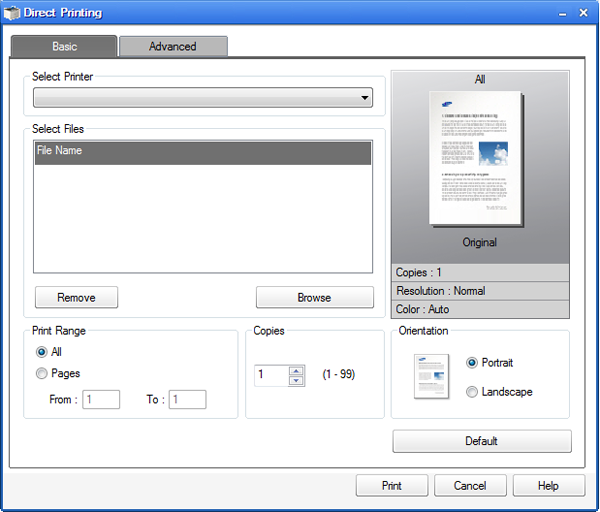
-
Select your machine from the drop-down list and click .
-
Select the PDF file you wish to print and click .
The PDF file is added in the section.
-
Customize the machine settings for your needs.
-
Click . The selected PDF file is sent to the machine.
Using the right-click menu
-
Right-click on the PDF file you wish to print and select .
The Direct Printing Utility window appears with the PDF file added.
-
Select the machine you wish to use.
-
Customize the machine settings for your needs.
-
Click . The selected PDF file is sent to the machine.
![[Note]](../common/note.png)
|
|
|
Most Windows applications will override settings you specify in the printer driver. Change all print settings available in the software application first, and change any remaining settings using the printer driver. |
-
Click the Windows menu.
-
For Windows 2000, select > .
-
For Windows XP/2003, select .
-
For Windows 2008/Vista, select > > .
-
For Windows 7, select > > .
-
For Windows Server 2008 R2, select > > .
-
-
Right-click your machine.
-
For Windows 2000, XP, 2003, and Vista, press .
For Windows 7 and Windows Server 2008 R2, from context menus, select the .
![[Note]](../common/note.png)
If item has ► mark, you can select other printer drivers connected with selected printer.
-
Change the settings on each tab.
-
Click .
![[Note]](../common/note.png)
|
|
|
If you want to change the settings for each print job, change it in . |
Setting your machine as a default machine
-
Click the Windows menu.
-
For Windows 2000, select > .
-
For Windows XP/2003, select .
-
For Windows 2008/Vista, select > > .
-
For Windows 7, select > > .
-
For Windows Server 2008 R2, select > > .
-
-
Select your machine.
-
Right-click your machine and select .
![[Note]](../common/note.png)
For Windows 7 and Windows Server 2008 R2, if item has ► mark, you can select other printer drivers connected with the selected printer.
You will sometimes need to save the print data as a file.
To create a file:
-
Check the box at the window.
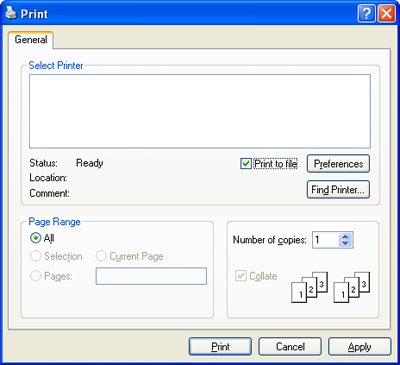
-
Click .
-
Type in the destination path and the file name, and then click .
For example c:\Temp\file name.
![[Note]](../common/note.png)
If you type in only the file name, the file is automatically saved in , or . The saved folder may differ, depending on your operating system or the application you are using.
![[Note]](../common/note.png)
|
|
|
Some features may not be available depending on models or options. |
This section explains how to print using a MAC.
Printing a document
When you print with a MAC, you need to check the printer driver setting in each application you use. Follow the steps below to print from a MAC:
-
Open the document you want to print.
-
Open the menu and click ( in some applications).
-
Choose your paper size, orientation, scaling, other options, and make sure that your machine is selected. Click .
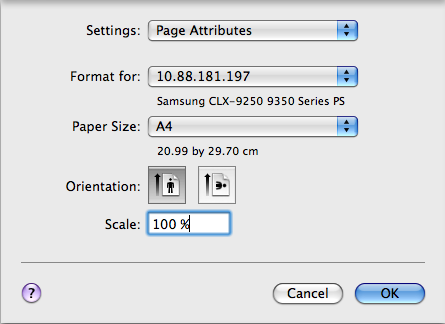
-
Open the menu and click .
-
Choose the number of copies you want and indicate which pages you want to print.
-
Click .
Activating optional devices or accessories
After installing the optional devices or accessories, you need to activate the options.
-
Open and click .
-
Select your machine and click .
-
Select and set the necessary options.
Changing printer settings
You can use advanced printing features provided by your machine.
Open an application and select from the menu. The machine name, which appears in the printer properties window, will differ depending on the machine in use. Except for the name, the composition of the printer properties window is similar to the following.
![[Note]](../common/note.png)
|
|
|
The following pane is the first pane you will see when you open the printer properties pane. Select other advanced features from the drop down list.
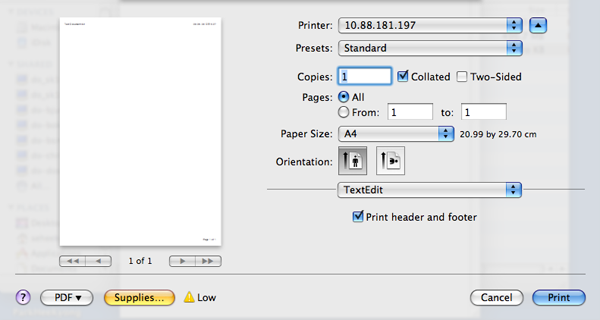
The tab provides options to adjust how the document appears on the printed page. You can print multiple pages on one sheet of paper. Select from the drop-down list.
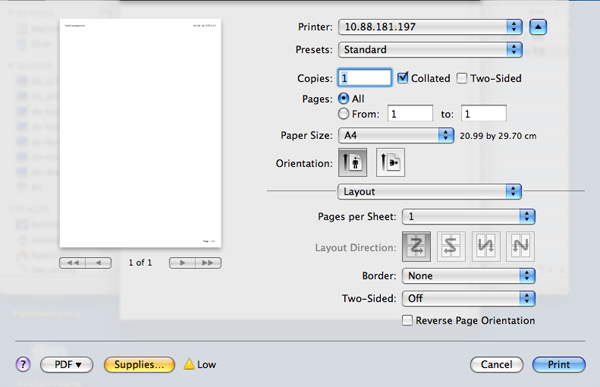
-
: This option determines how many pages are to be printed on one page (see Printing multiple pages on one sheet of paper).
-
: This option allows you to select the printing direction on a page similar to the examples in the UI.
-
: This option allows you to print a border around each page on the sheet.
-
: This option allows you to print on both sides of a sheet of paper (see Printing on both sides of paper).
-
: This option allows you to rotate the paper 180 degrees.
The tab provides options for selecting . Select from the drop-down list.
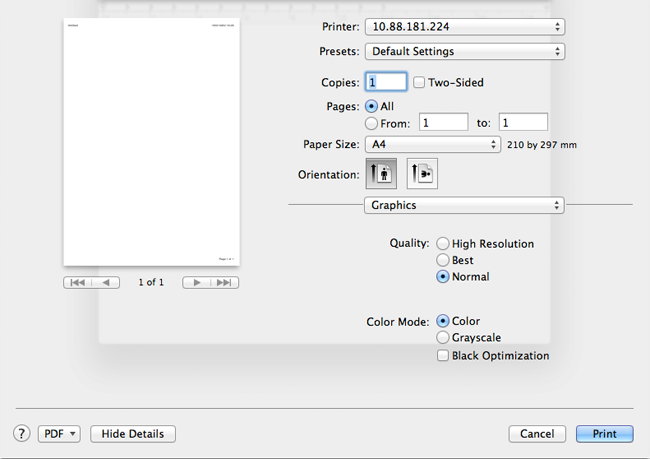
-
: This option allows you to select the printing resolution. The higher the setting, the sharper the clarity of printed characters and graphics. A higher setting also may increase the time it takes to print a document.
-
: You can set the color options. Setting to typically produces the best possible print quality for color documents. If you want to print a color document in grayscale, select .
This option allows you to print with the given permissions.
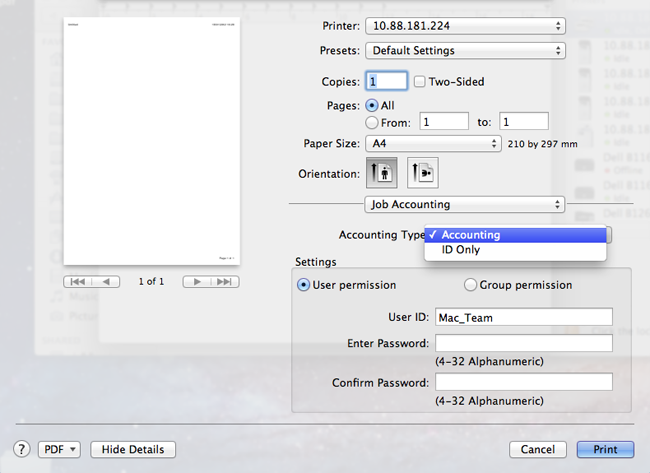
-
: You can select an accounting type specified by your system administrator.
-
Accounting: You can enable print authentication by user ID and password.
-
: You can enable print authentication by user ID only.
-
-
: If you check this option, only users with user permission can start a print job.
-
: If you check this option, only groups with group permission can start a print job.
![[Note]](../common/note.png)
|
|
|
This option allows you to choose how to print the file by using the hard disk drive in your machine.This option allows you to choose how to print or save the file by using the HDD in your machine.
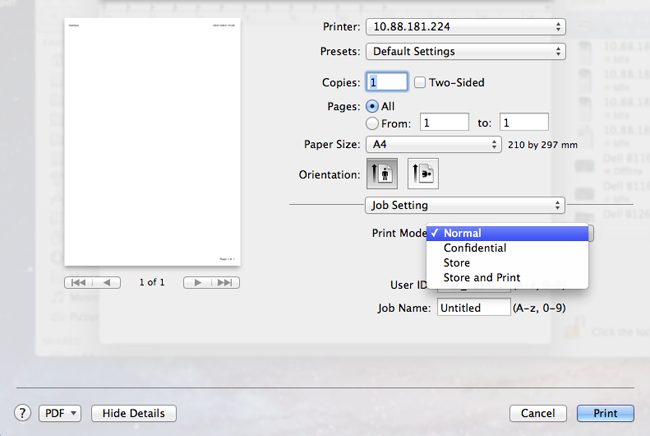
-
: The default is .
-
: This mode prints without storing your document.
-
: This mode is used for printing confidential documents. You need to enter a password to print it.
-
: This mode is used only for storing documents on the HDD. If necessary, you can load and print the stored documents. You can find the stored file in the (see Saving documents in the Stored Document).
-
: This mode is used when printing and storing documents at the same time. If necessary, you can load and print the stored documents. You can find the stored file in the (see Saving documents in the Stored Document).
-
: Use this option to enter a specific time to print the job. This is useful for printing large amount of data or if you want all your job to print at the same time. Select the date and time you want to print. and are used when you need to find a stored document using the control panel.
-
![[Note]](../common/note.png)
|
|
|
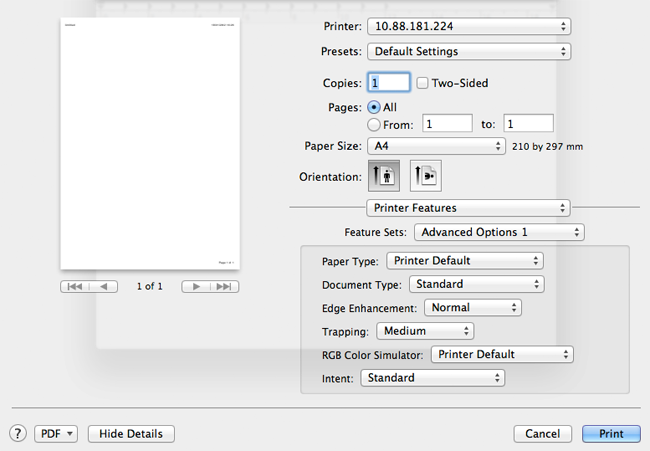
-
: You can select the print output options such as staple, offset and etc. This option is available only when the optional Inner Finisher or booklet finisher is installed.
-
: This feature prints your document on both sides of a paper and arranges the pages so that the paper can be folded in half after printing to produce a booklet. Some options in are available only when the optional stanard finisher or booklet finisher is installed.
-
: Prints the document with a front cover. The front cover can be a blank paper or the first page in the document.
-
: Prints the document with a back cover. The back cover can be a blank paper or the last page in the document.
-
: Prints the document with a front cover and a back cover. The covers can be blank papers or the first and the last pages in the document.
-
: This option allows you to correspond to the paper loaded in the tray from which you want to print. This will let you get the best quality printout. If you load a different type of print material, select the corresponding paper type.
-
Enhancement: This option allows you to emphasize edges of texts and fine lines for improving readability.
-
: This setting determines how colors are rendered. is the most widely used setting which the color tone of this mode is the closest to that of standard monitor (sRGB Monitor). mode is appropriate for printing presentation data and charts. The color tone of mode produces more color images than that of mode. mode is best used for printing fine lines, small characters and color drawings. The color tone of mode may be different from that of monitor, the pure toner colors are used for printing cyan, magenta and yellow colors. is most common color setting used in the corporate environment.
You can print more than one page on a single sheet of paper. This feature provides a cost-effective way to print draft pages.
-
Open an application, and select from the menu.
-
Select from the drop-down list under . In the drop-down list, select the number of pages you want to print on one sheet of paper.
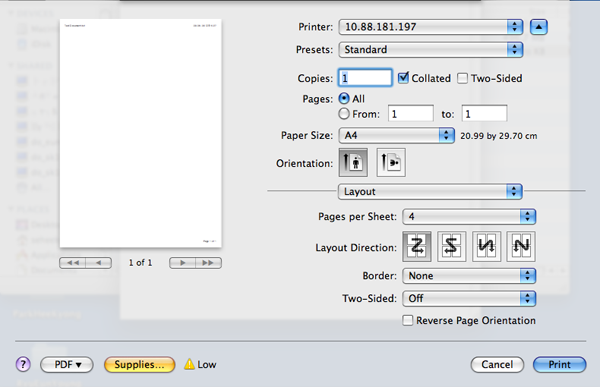
-
Select the other options you want to use.
-
Click , then machine prints the selected number of pages you want to print on one sheet of paper.
You can print on both sides of the paper. Before printing in the duplex mode, decide on which edge you will be binding your finished document. The binding options are as follows:
-
: This option is the conventional layout used in book binding.
-
: This option is the type often used with calendars.
-
From your MAC application, select from the menu.
-
Select from the drop-down list under .
-
Select a binding orientation from option.
-
Select the other options you want to use.
-
Click and; the machine prints on both sides of the paper.
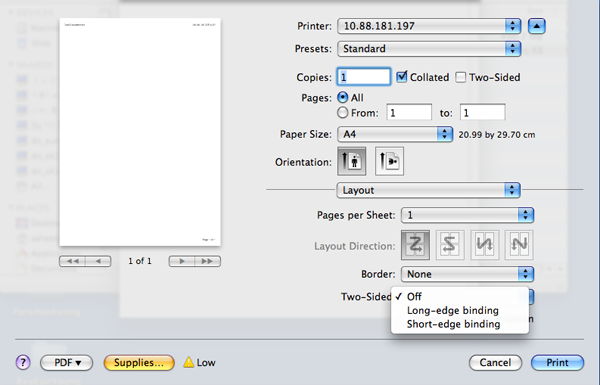
![[Caution]](../common/caution.png)
|
|
|
If you print more than 2 copies, the first copy and the second copy might print on the same sheet of paper. Avoid printing on both sides of paper when you are printing more than 1 copy. |
![[Note]](../common/note.png)
|
|
|
Some features may not be available depending on models or options. |
Printing from applications
There are a lot of Linux applications that allow you to print using Common UNIX Printing System (CUPS). You can print on your machine from any such application.
-
Open an application, and select from the menu
-
Select directly using LPR.
-
In the LPR GUI window, select the model name of your machine from the printer list and click .
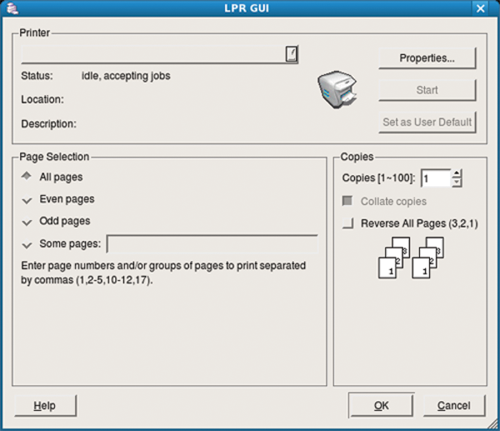
-
Change the print job properties using the following four tabs displayed at the top of the window.
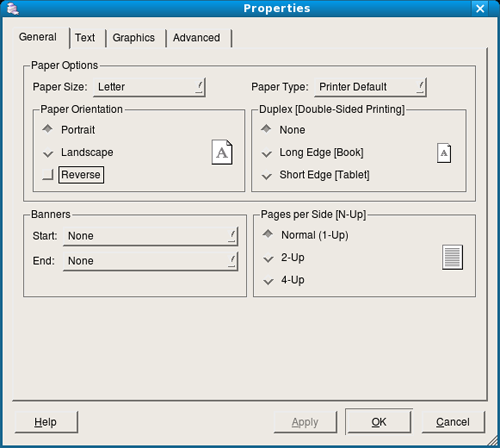
-
: This option allows you to change the paper size, the paper type, and the orientation of the documents. It enables the duplex feature, adds start and changes the number of pages per sheet.
-
: This option allows you to specify the page margins and set the text options, such as spacing or columns.
-
: This option allows you to set image options that are used when printing image files, such as color options, image size, or image position.
-
: This option allows you to set the print resolution, paper source, and destination.
-
-
Click to apply the changes and close the window.
-
Click in the window to start printing.
-
The Printing window appears, allowing you to monitor the status of your print job.
To abort the current job, click .
Printing files
You can print many different types of files on your machine using the standard CUPS, directly from the command line interface. The CUPS LPR utility allows you to do that, but the drivers package replaces the standard LPR tool with a much more user-friendly LPR GUI program.
To print any document file:
-
Type lpr <file_name> from the Linux shell command line and press Enter.
When you type only “LPR” and press , the window appears first. Just select any files you want to print and click .
-
In the window, select your machine from the list, and change the print job properties.
-
Click to start printing.
Using the window provided by the , you can change the various properties for your machine as a printer.
-
Open the .
If necessary, switch to .
-
Select your machine from the available printers list and click .
-
The window appears.
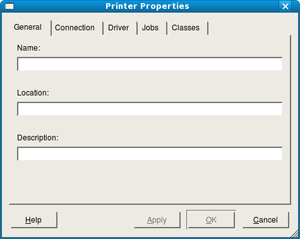
The following five tabs display at the top of the window:
-
: This option allows you to change the printer location and name. The name entered in this tab displays on the printer list in .
-
: This option allows you to view or select another port. If you change the machine port from USB to parallel or vice versa while in use, you must re-configure the machine port in this tab.
-
: This option allows you to view or select another machine driver. By clicking , you can set the default device options.
-
: This option shows the list of print jobs. Click to cancel the selected job and select the check box to see previous jobs on the job list.
-
: This option shows the class of your machine. Click to add your machine to a specific class or click to remove the machine from the selected class.
-
-
Click to apply the changes and close the window.
![[Note]](../common/note.png)
|
|
|
Some features may not be available depending on models or options. |
Proceeding the print job
After installing the printer, choose any of the image, text, or PS files to print.
-
Execute “” command.
For example, if you are printing “”
document1
This will open the UNIX Printer Driver in which the user can select various print options.
-
Select a printer that has been already added.
-
Select the printing options from the window such as .
-
Select how many copies are needed in .
![[Note]](../common/note.png)
To take advantage of the printer features provided by your printer driver, press .
-
Press to start the print job.
Changing the machine settings
The UNIX printer driver in which the user can select various print options in printer .
The following hot keys may also be used: “H” for , “O” for , “A” for , and “C” for .
tab
-
: Set the paper size as A4, Letter, or other paper sizes, according to your requirements.
-
: Choose the type of the paper. Options available in the list box are , , and .
-
: Select from which tray the paper is used. By default, it is .
-
: Select the direction in which information is printed on a page.
-
: Print on both sides of a sheet of paper to save paper.
![[Note]](../common/note.png)
Automatic/manual duplex printing may not be available depending on models. You can alternatively use the lpr printing system or other applications for odd-even printing.
-
: Print several pages on one side of a paper.
-
: Choose any of the border styles (e.g., , )
tab
In this tab, you can change the brightness, resolution, or image position of your document.
tab
Set the character margin, line space, or the columns of the actual print output.
tab
-
: Set the margins for the document. By default, margins are not enabled. The user can change the margin settings by changing the values in the respective fields. Set by default, these values depend on the page size selected.
-
: Change the units to points, inches, or centimeters.
tab
Select various options in the and frames to customize various settings. These options are specific to the printer and depend on the PPD file.
